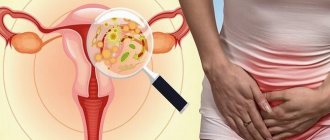There is no need to talk much about what abortion is. Most women know that this is a procedure for deliberately terminating a pregnancy. According to statistics, about 40% of women have had an abortion at least once in their lives. The procedure for terminating a pregnancy is perceived extremely negatively in society, and in the Orthodox sphere it is even equated with sin. In this article we will talk about the main reasons that push a woman to have an abortion, what types of abortion exist and how to move on after making such a psychologically difficult decision.
Do's and don'ts after an abortion: rehabilitation, discharge, sex life, pain, cycle restoration
Many women have undergone or are about to undergo an abortion; they are partially familiar with the potential complications and consequences, but do not fully understand the entire rehabilitation process and its necessity and duration.
Why is it necessary to exclude certain aspects from your usual lifestyle after an abortion? Certain prohibitions are included in the rehabilitation complex and help restore not only physical health, but also prevent possible infertility in the future (see consequences and complications of abortion).
Restoration of the menstrual cycle
Termination of pregnancy is a severe stress for the body, therefore, after an abortion, the regulation of the functions of the ovarian-menstrual cycle is disrupted. Due to the significantly increased load on all organs during gestation, the hypothalamus is in a state of excitement, which affects the work of the pituitary gland, which ceases to synthesize gonadotropins (FSH and LH) in the required proportions.
And instead of the periodic release of luteinizing hormone, characteristic of the normal menstrual cycle, its monotonous increased secretion is noted, as a result of which the ovaries enlarge and begin to synthesize estrogens. But with the physiological completion of pregnancy, all changes that occur disappear without consequences for health. With forced termination of pregnancy, the anatomical stage of menstrual dysfunction develops, which leads to the development of the following pathological conditions:
- insufficiency of the luteal (phase 2) cycle;
- secondary polycystic ovary syndrome;
- hyperplastic processes of the endometrium;
- uterine fibroids;
- syndrome or Itsenko-Cushing's disease.
The listed pathology is caused by excess production of LH after its previous monotonous secretion, so the restoration of ovarian-menstrual function sometimes takes more than one month, in some cases several years.
How many days after an abortion will menstruation begin is difficult to answer, it depends on a number of factors:
- woman's age;
- existing chronic diseases;
- method of abortion;
- gestational age when the abortion was performed;
- during the postoperative period.
Normally, a healthy and young woman should begin her period after an abortion in about a month, or rather, after the period of time that lasted from the previous menstruation to the current one. To calculate the approximate date of the first menstruation after the procedure, the starting point (the first day of the cycle) should be the day of the abortion.
However, artificial termination of pregnancy can not only lengthen or shorten the duration of the menstrual cycle, but also change the nature of the discharge. It is possible that scanty, spotting discharge may appear after an abortion, which continues for one to two menstrual cycles and is associated with incomplete restoration of the endometrium after the procedure.
If scanty menstruation persists for a longer time, this is a reason to consult a doctor, as well as for an extensive examination. A decrease in menstrual blood loss may be due to two reasons.
- The first is a functional failure in the production of hormones by the ovaries, pituitary gland and hypothalamus. Often, a similar condition is observed after a medical abortion, which is associated with taking very large doses of antiprogestins and requires the appointment of appropriate hormonal therapy.
- The second reason is mechanical damage to the endometrium (overly “thorough” scraping of the mucosa and traumatization of its deep layers) and/or the cervix (cervical canal atresia). When the endometrium is injured, synechiae (adhesions in the pelvis) are formed in the uterine cavity, which reduce not only its volume, but also the area of the endometrium, which is rejected during menstruation.
In addition to opsomenorrhea (scanty menstruation), amenorrhea and infertility may occur. Intrauterine synechiae requires hysteroscopic dissection.
If your periods after termination of pregnancy become heavier and repeat for several cycles, you should also be wary. Heavy and prolonged menstruation may indicate:
- or about the development of endometrial hyperplasia
- or about adenomyosis (endometriosis of the uterus).
And although menstrual flow after an abortion can be restored immediately, that is, it begins after 21–35 days, ovulation may be absent for two to three menstrual cycles, which is considered normal. If anovulation lasts longer, but there are no visible cycle disorders, you need to start looking for the cause of this pathology.
Why restore hormonal levels?
If measures are not taken, the confused body will give an undesirable reaction to abortion. Moreover, this may not happen immediately, but after a certain time. The entire internal secretion system is disrupted because the secretion of corticosteroids, estrogens, progesterone, follicle-stimulating and adrenocorticotropic hormone is disrupted.
Women during this period may experience:
- unexplained weight gain or loss;
- insomnia, nervousness, hand tremors, irritability;
- deterioration of skin condition;
- sexual problems - uterine bleeding, lack of menstruation, the appearance of cysts in the ovaries and lumps in the mammary glands;
- pressure surges, headaches, dizziness.
If these phenomena are not eliminated, a woman may experience thyroid dysfunction, multiple ovarian cysts (polycystic disease), menstrual dysfunction and infertility. Sometimes pregnancy occurs, but it is not possible to carry it to term.
To avoid unpleasant consequences, after an abortion you need to get tested for hormones.
The doctor will be able to prescribe medications that normalize hormonal levels. For the same purpose, after an abortion, it is a good idea to take oral contraceptives, which allow the ovaries to rest and recover. The gynecologists-endocrinologists of our clinic will determine the course of medication and their selection. How to restore hormonal levels after an abortion?
Discharge after the procedure
Immediately after an uneventful abortion, the discharge should normally be moderate, with a small number of clots. However, both the volume and duration of bleeding depend both on the duration of the terminated pregnancy and on the method of termination.
- Small and even scanty discharge is observed after a vacuum abortion. This is explained by the short duration of pregnancy, and, accordingly, minor trauma to the uterine mucosa.
- After a surgical abortion, especially at 10–12 weeks, the discharge will be more intense and prolonged.
How many days after an abortion does bleeding continue? The duration of bleeding after a well-performed procedure is normally 7, maximum 10 days. If the discharge continues for more than 10 days, the first thing to exclude is the placental polyp, which is removed by repeated curettage of the uterine cavity. That’s why it’s so important to see a gynecologist after 10–14 days, who will not only palpate the uterus and suspect subinvolution or placental polyp, but also prescribe a pelvic ultrasound.
If clots and heavy bleeding occur after an abortion, regardless of when it was performed, a day or 2 weeks ago, you should immediately seek qualified medical help, since the presence of remnants of the fertilized egg or hematometer in the uterine cavity cannot be ruled out.
Consequences of abortion for a woman
It is worth noting that all existing negative consequences of abortion can be divided into those observed immediately after the procedure and long-term ones. At the same time, the consequences of a medical abortion are not as pronounced as those observed after surgical curettage. Among the common consequences of any abortion:
- Bloody issues. Light discharge with blood after an abortion is observed for 2 weeks from the date of the procedure. They are accompanied by painful sensations in the lower abdomen.
- Perforation of the uterus. Violation of the integrity of the reproductive organ, accompanied by severe bleeding. Occurs during a surgical abortion and requires emergency care.
- Uterine bleeding. Possible if large vessels are damaged by the abortive instrument.
- Incomplete abortion. A complication of the abortion process, in which particles of fetal tissue remain in the uterine cavity. The uterus needs to be surgically cleaned out.
- Infection of the reproductive system. It is observed when abortion technique is violated, or when unsterile instruments are used.
Abdominal pain in the post-abortion period
After an uncomplicated termination of pregnancy, moderate pain in the lower abdomen or slight discomfort is normally possible. Such sensations can last up to 7 days and do not particularly bother the patient. If your stomach hurts so badly that it is impossible to lead your usual lifestyle and leads to loss of ability to work, this is a reason to immediately contact a specialist.
- Cramping and sharp pain indicate the remains of placental tissue and embryo in the uterine cavity and the development of hematometra
- Aching, constant pain combined with an elevated temperature after an abortion are a sign of the onset of inflammation, which can be triggered by sexually transmitted infections that remain asymptomatic for some time.
- In general, in the first 2 days after the procedure, a slight increase in temperature (37.2 - 37.3) is not a pathology, but only reflects the body’s reaction to surgery. Low-grade fever is also possible on the day of a medical abortion as a reaction of the thermoregulation center located in the brain to taking high doses of hormones.
- But if a high temperature (more than 37.5) persists for more than 2 days, this is a sign of trouble and a reason to seek medical attention. help.
To prevent the development of inflammatory diseases after medical termination of pregnancy, patients, especially those with unsatisfactory results of smears and blood/urine tests, are prescribed a prophylactic course of broad-spectrum antibacterial and anti-inflammatory drugs for 3 to 5 days (maximum 7 days). In the case of a confirmed inflammatory process, the dose of antibiotics is increased and the course lengthened.
Also, to prevent septic post-abortion complications, the doctor will definitely recommend staying away from drafts and colds, dressing warmly in damp and cold weather, and taking a shower daily. Equally important is following the rules of personal hygiene:
- treating the external genitalia with water at least 2 times a day;
- timely change of pads and underwear, since the blood spilled from the uterine cavity and retained on intimate hygiene products is a good breeding ground for microorganisms, which contributes to their active reproduction and penetration into the uterus, where they cause inflammation.
Every woman who has artificially terminated a pregnancy should know that drinking alcohol in the post-abortion period is strictly prohibited, especially if she is taking antibacterial drugs.
- Firstly, under the influence of alcohol, antibiotics are destroyed, which means that taking them will be absolutely useless and will not reduce the risk of developing post-abortion septic complications.
- Secondly, alcohol reduces the tone of smooth muscles (the myometrium consists of smooth muscles), which prevents its contraction and involution (return to its previous size) after removal of pregnancy and can cause bleeding.
Advice from a gynecologist
The recovery period after an abortion is a mandatory procedure, even if the abortion was successful. The patient should be observed by a gynecologist throughout the entire period until the menstrual cycle is restored (15-40 days). The danger of the consequences of an abortion is that they do not always appear immediately after the procedure. It also happens that hormonal imbalance occurs after some time against the background of exacerbation of diseases that have not bothered the patient for a long time.
If you do not pay attention to the signs of hormonal imbalance, then mild symptoms turn into severe hormone-dependent diseases: uterine fibroids, polycystic ovaries, salpingitis, oophoritis, endometritis. Against this background, a diagnosis of infertility is often made. This outcome is not uncommon and is typical specifically for those patients who neglected the gynecologist’s recommendations and took the recovery period lightly.
So, the choice of a woman who decides to have an abortion, if possible, should fall on non-surgical methods.
To prevent inflammatory processes, as a rule, the doctor prescribes the use of broad-spectrum antibiotics 1-2 days before the abortion. It is advisable to remain under medical supervision after an abortion until the normal menstrual cycle is restored. Sexual life after non-surgical abortions can be resumed after about 7-14 days, after instrumental abortions - no earlier than a month.
And at the end of the article, I would like to remind you once again: the main way for optimal family planning and reducing the number of abortions is the competent use of modern methods of contraception.
| Non-surgical methods of abortion | |
| Homeopathy | Efficiency is no more than 20%. |
| Acupuncture | Efficiency is up to 40% with a short (10-15 days) delay and depends on the qualifications of the specialist. |
| Magnetic induction (“magnetic cap”) The method is based on artificial disruption of the normal transmission of electrical impulses from the uterus to the brain, causing contractile activity of the uterus and provoking a miscarriage. | Efficiency is 50% with a delay of no more than 3-5 days, used only in the absence of contraindications. |
| Medical abortion (“French pills”) Specific uterine receptors responsible for the development and maintenance of pregnancy are blocked, resulting in expulsion of the fertilized egg. | Efficiency is 90-95% with a delay of up to 42 days. |
| Surgical methods of abortion | |
| Vacuum aspiration (“mini-abortion”) | During pregnancy up to 4-5 weeks. |
| Medical abortion Instrumental removal of the fertilized egg with simultaneous curettage of the uterine cavity. | During pregnancy up to 12 weeks. |
| “Late abortion” Solutions are injected into the fetal bladder to induce labor. | For periods of more than 12 weeks of pregnancy for special indications. |
| Minor caesarean section | Termination of a long-term pregnancy for medical reasons. |
Alexey PutintsevObstetrician-gynecologist, Women's Health Center on Kutuzovsky Prospekt, Moscow
Uterus after abortion
The most damaged organ after an abortion is the uterus. The longer the abortion was performed, the more significant its damage. This is especially true for instrumental curettage of the embryo.
The uterus after an abortion begins to contract immediately after the embryo is removed and returns to its normal or almost normal size by the end of the procedure. However, a wound surface is formed on the uterine wall (in the place where the fertilized egg was attached), which requires a certain time period for its healing and restoration of the endometrium, ready for transformation and rejection during menstruation.
- Normally, this takes 3–4 weeks, and by the beginning of a new menstruation (after a previous abortion), the uterus has its normal size and transformed epithelium.
- But if, upon examination 10 to 12 days later, which is mandatory after the procedure, an enlarged, softened and painful uterus is palpated, and the discharge is dark red or the color of “meat slop”, with an unpleasant odor, scanty or moderate, then we are talking about inflammation of the organ.
The causes of endometritis can be a poorly performed abortion (remnants of the fertilized egg), activation of a latent infection or infection during the abortion (violation of aseptic standards) or after (non-compliance with recommendations), or the formation of hematometra. Therefore, all women after an abortion are prescribed not only a follow-up visit to the gynecologist, but also a mandatory ultrasound, during which it is confirmed that the uterus is “clean”.
Additional recommendations
If during the recovery period you notice the appearance of severe pain, heavy bleeding, changes in the structure of the discharge, its smell or color, be sure to contact your doctor as soon as possible. Since these may be signs of quite serious complications.
Our directory for private clinics in Moscow “Your Doctor” will find you an experienced, qualified gynecologist in an area close to your place of residence, and will also help you make an appointment with him at a convenient time.
Publication date: 2019-05-13
Useful information on the topic:
- Calling a gynecologist to your home
- Consultation with a gynecologist
- HCG tests
- Ultrasound during pregnancy
- Diagnosis of sexually transmitted diseases
- Fetal ultrasound
- Pelvic ultrasound
- Ultrasound during pregnancy
- Transvaginal ultrasound
- Discharge in women
Sex life after abortion
Based on the above, it becomes clear that sex after an abortion must be excluded. The gynecologist will definitely warn a woman who has undergone an abortion procedure that she should observe sexual rest for at least 3 weeks (after a mini-abortion and pharmacological abortion).
Over the specified period of time, the uterus should return to normal. But in the case of instrumental or classic abortion, especially in long periods, the prohibition of sexual activity is extended to 4 weeks, optimally until the end of menstruation.
- Firstly, this is due to the high risk of infection of the uterus and the development of inflammation
- Secondly, sexual intercourse can disrupt the contractile activity of the uterus, which will provoke its subinvolution or hematometra, and again lead to inflammation.
- In addition, having sex can cause pain after an abortion.
What is needed for normal physical recovery in the post-abortion period↑
Recommendations for rapid physical recovery
Firstly, proper and nutritious nutrition. A balanced diet rich in iron and proteins (liver, beef, buckwheat porridge, pomegranate juice) is recommended to prevent anemia caused by blood loss.
Alcohol and smoking are strictly prohibited!
Secondly, the work and rest regime. It is necessary to exclude heavy physical labor, visiting fitness rooms, saunas and swimming pools - this can increase uterine bleeding.
Follow your gynecologist's recommendations regarding intimate hygiene and sex life. Hygienic procedures are recommended only in the form of a shower to prevent infection from entering the uterus, which is still open, and also to prevent severe blood loss after an abortion. Sexual activity should not begin before 3-4 weeks.
Probability of pregnancy after abortion
Not many former clients of the abortion clinic know that after an abortion you can get pregnant, and very quickly, even before the onset of your first menstruation. In this case, a parallel can be drawn with pregnancy, which occurs immediately after the birth of a child if a woman refuses lactation.
After the sudden termination of pregnancy, the body begins to actively rebuild and returns to its usual rhythm. That is, the ovaries are preparing for a new menstruation; under the influence of pituitary gonadotropins (FSH and LH), they gradually produce estrogens and then progesterone, which stimulates the maturation of follicles and ovulation.
Therefore, in more than half of the cases, a woman’s first ovulation occurs within 14–21 days. And if we take into account the lifespan of sperm (up to 7 days), then pregnancy after an abortion is very likely.
On the other hand, if a woman, after a recent termination of pregnancy due to circumstances, wants to give birth to a child, then it is necessary to abstain from pregnancy for a certain time.
It is believed that the minimum period of birth control after a previous abortion is 6 months. It is optimal if the desired pregnancy occurs within a year, and after a thorough examination and treatment of identified diseases.
It is during this period of time that the body will fully recover, and the risk of pregnancy complications associated with its previous violent termination will noticeably decrease (isthmic-cervical insufficiency, hormonal imbalance, improper attachment of the fertilized egg, intrauterine growth retardation).
Also, speaking about pregnancy that occurred immediately after an abortion, we should also talk about tests to determine it. After an abortion, the test will be positive, and this result will remain for another 4 to 6 weeks (if the termination of the pregnancy was long, the positive result will remain longer).
HCG is not immediately destroyed and excreted from the woman’s body, this process is quite slow, therefore a positive result cannot be considered a sign of pregnancy (the case of either the ovum not being removed during an abortion, or the onset of a new one). The only thing that can cast doubt on the “positivity” of the test is that the second line in each new test will be lighter (see pregnancy test).
To accurately establish the fact of pregnancy, an ultrasound is performed, and in some situations, a blood test for hCG several times in a row; in the case of a progressive decrease in the level of hCG in the tests, a false positive test result is indicated.
Surgical abortion. Hormonal changes
WHO data shows that the endocrine system suffers most as a result of abortion. Even in previously healthy women, the hormonal balance takes at least 6-12 months to recover, and the exacerbation of pre-existing chronic diseases further intensifies the situation.
The changes in the production of the following hormones affect the most:
- corticoid hormones;
- estrogen and progesterone;
- follicle-stimulating hormone;
- adrenocorticotropic hormone.
Statistics say that if hormonal levels are not normalized after an abortion, within 3-5 years 6% of women develop adenomyosis (internal endometriosis - the growth of the mucous membrane into the muscle tissue of the uterus). When using an intrauterine device after an abortion without hormonal treatment, the incidence of adenomyosis increases to 9%.
Neuroendocrine disorders after abortion are expressed in excitation of the hypothalamic-pituitary system, due to which glucocorticoids and estrogens are produced at elevated levels. To restore hormonal levels, it is necessary to combine inhibitory (suppressing production) agents (estrogen-gestagen drugs) with diet, physiotherapeutic procedures and taking vitamins.
In order to normalize hormone levels, the gynecologist selects special hormonal contraceptives. They solve two problems at once:
- They protect against unwanted pregnancy, which may well take place - women often seek a repeat abortion in the first 2-3 months;
- Reduce the activity of the hypothalamus and normalize the production of estrogen and progesterone.
Most often, after an abortion, COCs are prescribed - combined oral contraceptives. These modern drugs also have a beneficial effect on cholesterol levels, in particular, they reduce the level of “bad” low-density lipoproteins and increase the content of “good” high-density lipoproteins, thereby reducing the risk of developing atherosclerosis.
Maintaining hemostasis (fluid state of the blood) and restoring estrogen and progesterone levels reduces or eliminates uterine bleeding. The risk of developing endometriosis after taking COCs is reduced by 50%, ovarian cancer by 60%, and benign neoplasms by 70%. In order to avoid metabolic syndrome (metabolic changes), a treatment course of COCs is prescribed for 5-6 months.
The gynecologist prescribes hormone tests to the patient, and based on their results, determines what contraceptives she should take to restore hormonal levels. Depending on the degree of hormonal imbalance, combined monophasic contraceptives or triphasic oral contraceptives are prescribed.
The purpose of a particular drug depends on the content of gestagen, an analogue of progesterone, in its composition.
- Monophasic COCs include Janine, Lindnet-20 or 30, Novinet, Regulon, Yarina, Marvelon.
- Triphase contraceptives include Triquilar, Qlaira, and Tri-Mercy.
You cannot take these pills on your own! They have contraindications and side effects. In particular, COCs should not be taken if you have a history of:
- thromboembolism;
- thrombosis;
- high blood pressure;
- cardiac ischemia;
- suffered a heart attack or stroke;
- diabetes;
- tumors in the organs of the reproductive system;
- liver diseases (hepatitis, cirrhosis);
- smoking over the age of 35 years.
14 days after the abortion, the woman is tested for hCG. Normally it should be reduced. If the hCG concentration is relatively high, this indicates an ongoing pregnancy. After taking a course of oral hormonal contraceptives (they are taken for 21 days, then a break of 7 days is taken and the course is repeated for 21 days), the patient takes a blood test for hormones.
In cases where a woman does not want to continue her pregnancy, she is offered to resort to medical abortion for up to 6 weeks from the moment of conception (42 days from the date of the last menstruation). At this stage, the fertilized egg is barely established in the endometrium and is poorly attached to the uterus. In addition, significant hormonal changes in the body have not yet occurred, and it will be easier for a woman to endure the consequences of an abortion.
Abortion medications are not hormonal, but directly affect the entire hormonal system.
- Medicines used for medical abortion are based on the action of the drug Mifepristone, a synthetic steroid drug that blocks progesterone receptors. 200 mg of Mifepristone causes a sharp drop in the level of progesterone, which is responsible for maintaining pregnancy. The endometrium grows, and the fertilized egg loses contact with the uterus.
- After a certain time (1-1.5 days), the patient takes Mifegin, a synthetic analogue of prostaglandins, physically active substances that cause uterine contractions. The fertilized egg is expelled from the uterine cavity. A few days later, the patient comes for a control ultrasound to make sure there is no pregnancy. If it persists, then it is all the more necessary to have an abortion, because sudden hormonal changes have an extremely negative effect on the embryo. However, the effectiveness of medical abortion is 98%, and surgical intervention is extremely rarely resorted to.
Normally, the patient’s hormonal levels are restored during the cycle. Ovulation is restored within a month. However, hormonal imbalance is quite possible, because steroid drugs affect the entire body.
Consequences of medical abortion:
- Pressure surges, general deterioration in well-being (prostaglandins contribute to the contraction of not only the muscles of the uterus, but also the blood vessels, as a result they contract, and a decrease or increase in pressure occurs).
- Tachycardia occurs, the pulse quickens (this is the effect of prostaglandins on the heart muscle);
- Chronic bronchitis/bronchial asthma worsens (prostaglandins relax the smooth muscles of bronchioles and cause bronchoconstriction);
- An overdose of Mifepristone causes uterine bleeding;
- Medical abortion at more than 6 weeks of pregnancy leads to incomplete abortion and preservation of the ovum;
- Digestive problems worsen in patients with stomach diseases
In general, medical abortion does not have serious side effects. They occur in two cases: with incorrect dosage and violation of the dosage regimen, as well as when using the drug more than once a year.
Vacuum abortion or vacuum aspiration is carried out up to 7 weeks of pregnancy and consists of artificially terminating pregnancy by sucking out the fertilized egg using a vacuum pump. The procedure does not require dilation of the cervix, and the separation of the fertilized egg does not occur surgically, but spontaneously under pressure.
Despite a relatively gentle method of terminating pregnancy, vacuum aspiration also leads to hormonal imbalance. This is especially true for young (teenagers) and women who have never given birth before.
The menstrual cycle after the procedure is more difficult to restore than in the case of medical abortion. For 10 days after vacuum aspiration, the woman observes bleeding, but there is no talk of full menstruation. Normally, the first menstruation after the procedure occurs within 30-50 days.
But for complete restoration of the pelvic organs, time must pass. In women who have previously given birth, the reproductive system turns on after 3-4 months, in women who have not previously given birth - after six months. Although the chance of getting pregnant remains high, therefore after a vacuum abortion you need to protect yourself for some time with condoms.
In most cases, the doctor prescribes hormonal contraceptives to the woman after vacuum aspiration, so that a sharp drop in the level of progesterone and estrogen does not cause the development of tumors. The fact is that during pregnancy the level of hormones increased evenly. Then the fertilized egg was removed, but the female body has an adaptation system.
The body experiences extreme stress during an abortion. The hypothalamus is still excited, it does not have time to rebuild, so the pituitary gland actively produces prostaglandins. For this reason, the ratio of FSH and LH is disrupted. Increased secretion of follicle-stimulating hormone leads to an increase in the size of the ovaries, which secrete estrogen above normal. The increase in luteotropic hormone activates the adrenal glands, which produce glucocorticosteroids.
The only way to avoid the consequences of hormonal imbalance after an abortion is close cooperation between the patient and the doctor.
Surgical abortion is performed before the 12th week of pregnancy and is the most traumatic among all types of abortion. The endocrine system is especially affected. By the 11th, the concentration of human chorionic gonadotropin reaches its peak, so abortion causes its sharp drop.
The hormonal system is under extreme stress. The corpus luteum does not dissolve for a long time, and the body remains for a long time in a state similar to that which occurs before ovulation. For this reason, menstruation after an abortion occurs very late, sometimes only after hormonal therapy.
Despite the difficult recovery, 40% of women in Russia consider artificial termination of pregnancy an acceptable method of pregnancy planning. Various complications slow down the normalization of hormonal levels. In addition to contraceptives, the woman takes medications and antibacterial drugs. The body works in stress mode, for this reason recovery is quite slow.
At the same time, the recovery period after an abortion is extremely important. If no action is taken, abortion has serious consequences. These include:
- uterine bleeding;
- slowing down proliferation (recovery of damaged tissue);
- inflammation and damage to the endometrium;
- increased excitability of the hypothalamic-pituitary system;
- deficiency of estrogen and progesterone;
- perforation of the uterus.
40% of the causes of infertility in women are the consequences of abortion, in particular, illiterate restoration.
An abortion performed in a medical facility is always accompanied by measures aimed at minimizing the consequences of the intervention. The doctor observes the woman immediately after the procedure, as well as for 1-3 months after. He prescribes medications that have a positive effect on the endocrine and reproductive systems.
Contraception issues
Immediately after an abortion, or better yet before the procedure, it is necessary to select a method of contraception. The optimal solution in this case is to take hormonal contraceptive pills, as they mitigate the effects of hormonal stress, prevent neuroendocrine disorders, and, in addition, significantly reduce the risk of developing septic complications after abortion, which is explained by the following mechanisms:
- reducing the amount of blood lost during menstruation (blood acts as a breeding ground for microbes);
- thickening of the cervical mucus, which not only prevents the penetration of “live creatures” into the uterine cavity, but also pathogens;
- the cervical canal does not expand so significantly during menstruation (protection against infection);
- the intensity of uterine contractions is reduced, thereby reducing the risk of the spread of pathogens of infectious diseases from the uterus to the tubes.
It is recommended to take low-dose oral contraceptives, the dose of ethinyl estradiol in which does not exceed 35 mcg, since estrogens increase blood clotting, and hypercoagulation is noted during the first 20 to 30 days after termination of pregnancy. Such drugs include Regulon, Rigevidon, Mercilon.
Taking the pills should start on the day of the abortion and continue according to the schedule. The day of termination of pregnancy will be counted as the first day of a new cycle.
A little history
In Ancient Greece and Rome, the life of the fetus was not protected by law.
Artificial termination of pregnancy was not punished in any way. It was punished only in cases where it was carried out for selfish purposes or for other base motives. At that time, ergot preparations were used to produce abortion, a plant that causes spastic contractions of the uterine muscles and expulsion of the fetus. According to Christian doctrine, the fetus has a soul from the moment of conception, and therefore its destruction in the womb is a great sin, aggravated by the fact that a child, deprived of the opportunity to be born, is also deprived of the grace of baptism. Therefore, in the Middle Ages, abortion was classified as a serious crime, similar to the murder of a relative.
Under the influence of the church in the 16th century, in almost all European countries (England, Germany, France), abortion was punishable by death, which was later replaced by hard labor and imprisonment. Moreover, this concerned not only the doctor, but also the patient. This situation persisted in many countries until the 1st half. XX century In England, abortion was legal for medical reasons, as well as in the case of pregnancy after rape.
Question answer
Is it possible to take a bath after an abortion?
During the post-abortion period (about a month), taking a bath is not recommended, as this may cause bleeding or the development of endometritis.
Is it permissible to use sanitary tampons after an abortion?
For intimate hygiene products after an abortion, preference should be given to pads, and the use of tampons is strictly prohibited, since bloody discharge absorbed by the tampon remains in the vagina with it and is an excellent environment for the proliferation of microorganisms, which increases the risk of developing post-abortion inflammation.
How long after an abortion can I go to the swimming pool?
Visiting the pool, as well as bathhouses and saunas (air temperature is too high), swimming in open water should be postponed for at least a month, until the end of the first menstruation. Otherwise, you can “catch” an infection or increase bleeding, even bleeding.
Can I exercise after an abortion?
If the termination procedure “passed” without complications and the woman’s condition is satisfactory, then you can return to sports within a couple of weeks after the termination of pregnancy. But the load should not be so intense during the month after the abortion.
Why does the breast hurt and bother you after an abortion (the abortion was performed 3 days ago)?
Perhaps the term of the terminated pregnancy was long enough, and the mammary glands began to actively prepare for the upcoming lactation. But a suddenly terminated pregnancy led to a hormonal imbalance; the body and mammary glands, among other things, did not have time to rebuild, which led to chest pain.
Are there any restrictions on food after an abortion?
No, you do not need to follow a special diet during the post-abortion period. But if the abortion took place under general anesthesia and the anesthesiologist diagnosed an allergic reaction to the anesthetic, he may advise further adherence to a hypoallergenic diet (limiting chocolate, citrus fruits, coffee, seafood and other allergenic foods).
A week passed after the abortion, I wanted to go to the seaside, is it dangerous?
The trip to the sea will have to be postponed. Firstly, a sharp change in climatic conditions is unfavorable for the restoration of the body, and, secondly, swimming in the post-abortion period is prohibited.
Source of the article: https://zdravotvet.ru/chto-mozhno-i-nelzya-posle-aborta-reabilitaciya-vydeleniya-polovaya-zhizn-boli-vosstanovlenie-cikla/
Rehabilitation period↑
How to restore the body after an abortion? At this point, it is imperative to undergo research, including the following:
- Visit to the doctor. It is necessary to do an examination of the pelvic organs to identify the remains of the embryo in case of incomplete abortion. Ultrasound examination is indicated one week after the procedure, when clinical signs such as bleeding disappear.
- It is necessary to do an ultrasound of the mammary glands to exclude the occurrence of formations after manipulation.
- A gynecologist-endocrinologist will tell you how to normalize hormonal levels so that menstruation resumes.
- You should definitely make an appointment with a psychologist, as many women find it very difficult psychologically. With the help of medical recommendations, you can recover and overcome this period faster.
You need to pay close attention to the advice of specialists who know the answer to the question of how to recover after an abortion. Otherwise, you will take a long time to recover and increase the chances of unwanted consequences and infection.
Recovery after medical termination of pregnancy
Thanks to modern technologies for abortion, a woman has the opportunity to preserve her reproductive function, so that even after the procedure she can conceive and successfully carry a child without problems. However, for this it is extremely important to follow certain recommendations from doctors for recovery after medical termination of pregnancy.
Immediately after the procedure
After a woman takes her second dose at a health care facility, she may spend some time under medical supervision to make sure there are no dangerous short-term side effects. After this she is allowed to go home. However, it is desirable that for some period of time someone close to her will be present who will support her, and if necessary, provide any assistance.
Often women report severe pain and heavy bleeding. This is provoked by the action of the drug and acts as a natural reaction. You can relieve pain with the help of no-spa or some other drugs recommended to the woman by the doctor.
Bleeding is also not dangerous until it becomes too profuse. The upper limit of what is allowed is one large pad, which fills in an hour. In this situation, you should contact an ambulance immediately.
A few days after the abortion, you need to visit a medical facility again to undergo a repeat ultrasound examination. In 1-2 percent of cases, the fertilized egg does not leave the uterus. In this case, it must be removed using curettage or vacuum aspiration.
Within 2-3 days the bleeding should stop, being replaced by fairly weak spotting. In this form, it can last on average from 1 week to a month.
The day bleeding begins is considered the first day of the menstrual cycle, but menstruation should begin after the usual number of days.
General advice for women on recovery after medical termination of pregnancy
Usually, after a medical abortion, doctors give general recommendations aimed at the normal recovery of the patient, which should minimize the risk of any dangerous consequences. The main ones:
In the first 3-4 weeks after termination of pregnancy, you must completely avoid going to the pool, sauna, solarium, and you should also not swim in open water or bathtubs.
You should temporarily avoid physical activity and get plenty of rest.
You need to adhere to proper nutrition, a maximally balanced diet, and take a complex of vitamins.
You need to monitor your condition very carefully, especially the nature of vaginal discharge. If they become too abundant, an unpleasant odor or skin irritation appears, you should immediately consult a doctor.
Sexual intimacy should be completely abandoned until the end of the first menstruation.
If the monthly cycle does not return to normal within 2-3 months, additional examination may be necessary, as well as correction of the woman’s hormonal levels.
In the first six months after termination of pregnancy, it is necessary to carefully protect against possible pregnancy, as it will be an extremely serious burden on the woman’s weakened body.
Follow these tips to help you recover from medical abortion
, you can significantly reduce the likelihood of developing side effects and consequences negative for women’s health.
Pregnancy after medical termination of pregnancy
In fact, having had a medical abortion, a woman is likely to have another pregnancy within 15 days. You need to understand that such an early pregnancy is highly undesirable, since the body needs more time to fully recover after medical termination of pregnancy
.
Therefore, the best option would be to use contraception during sexual intercourse for at least six months after the procedure. It is necessary to understand that you should not select a contraceptive on your own - this issue must be entrusted to an experienced doctor who knows the woman’s body and understands the importance of the correct prescription.
What is the probability of miscarriage after medical termination of pregnancy?
This question interests most women who have undergone or are planning to undergo a medical abortion procedure. In fact, pharmacological termination of pregnancy is not capable of causing a miscarriage in the future, after some time (provided that the manipulation was successful at the time). However, there is one “but”, which is that quite often a woman becomes pregnant before her body recovers. In such a situation, there is, of course, a possibility of miscarriage. However, in this case, the cause will not be medical termination of pregnancy, but the unpreparedness of the body and personal ignorance.
For a woman’s body to fully recover after an abortion, some time must pass, more precisely, at least six months. Only after such a period of time, using all the above recommendations for recovery after a medical abortion, is it likely that an absolutely normal pregnancy will occur without any consequences.
It is important to understand that even if a miscarriage occurs, or if the course of pregnancy is completely normal, you should still immediately consult a doctor. Only after going through all the examinations that the doctor prescribes can you be sure that everything is fine with you and your unborn baby.
Source of the article: https://www.probirka.org/biblio/polezno/9206-vosstanovlenie-posle-medikamentoznogo-prerivaniya-beremennosti
When should you consider abortion?
The lion's share of abortions is committed by girls who did not plan pregnancy and are not ready for it financially or morally. But we will not talk about this in detail now. Instead, we will look at situations where pregnancy can directly harm the life and health of the expectant mother.
First of all, it is necessary to mention that the woman has chronic diseases, such as heart or kidney failure. The fact is that during pregnancy the disease can worsen and threaten not only the health of the pregnant woman, but also her life.
The second most common case is the identification of developmental anomalies or other problems in the fetus that can either threaten the mother’s life during childbirth or cause the child’s early death after birth. It is not uncommon for children with such disabilities to become disabled for life.
Doctors recommend terminating a pregnancy if a woman is diagnosed with breast or uterine cancer. Since the rapid development of cancer cells can be detrimental to the expectant mother, she needs to urgently begin treatment to try to defeat the disease at an early stage.











